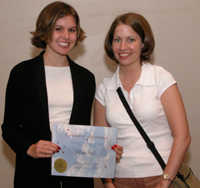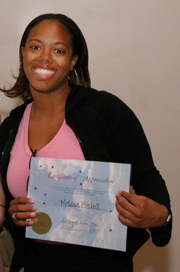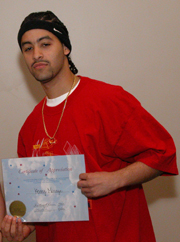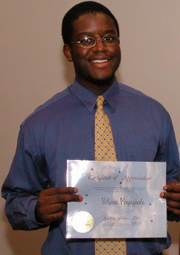 |
| Allison Krull, AS 2006, (left) accepts a certificate of recognition for her participation in the Unity Project from Jamie Jackson, residence life diversity fellow. |
3:30 p.m., May 27, 2003--More than 650 students participated in UD’s Unity Project, a five-month series of intensive diversity programs offered campuswide.
Twenty-two students attended five or more programs and were honored Sunday, May 4, at a Unity Project reception at Clayton Hall. Besides being honored, the students earned an additional semester priority credit in the housing application process. The reception also recognized those who helped to make the programs a reality.
Michele Michaelon, assistant director of residence life, said they were thrilled by the level of participation and enthusiasm. “We believe that with more students engaging in dialogue about diversity issues, our residence halls and campus community will be a more welcoming and supportive environment for all students.”
 |
| Melanie Mitchell, CHEP 2004 |
“We are especially proud of the 22 students who not only were interested in individual programs, but embraced the Unity Project as a whole,” she said. “They are terrific examples of the kind of commitment to learning and diversity that we expect of all students living in the residence halls.”
Typically two-hours long, unity projects were held in residence halls and at other campus locations. Presented by graduate students, professional staff, faculty and invited speakers. The programs focused on a wide variety of issues including race/ethnicity, gender, sexual orientation, class, ability, religion and general oppression.
Many of the programs were experiential, offering students an in-depth opportunity to explore differences of all kinds.
For example, for “Cardboard City” students built a living environment made from cardboard boxes and other found objects on the grounds behind the Perkins Student Center. The idea was to attract passersby to visit the cardboard city, complete with statistics and facts about homelessness and poverty in America. Homeless persons from Emmaus House in Wilmington, spoke about their firsthand experiences.
 |
| Kenny Minaya, AS 2005 |
“Dinner with a Twist” gave students the experience of eating with a handicap.
Unity Project award recipient, Melanie Mitchell, a CHEP sophomore, ate her meal tied, at the leg, to three other students. “A lot of times, we take things for granted. Those two hours made me realize I have a lot to be thankful for,” Mitchell said. “I would have gone to all of the Unity Project programs if I could.”
Delilah Guzman, a freshman in the College of Arts & Sciences, said she was a bit cynical as to how the University was going to encourage diversity. “The campus is not really diverse, we wanted to see what the University would come up with, and if it would really help.”
 |
| Pelumi Magbagbeola, AS 2005 |
After participating in five projects, Guzman said she was impressed. “I feel better. It shows UD is trying to do things to make students more accepting of other cultures. Some people seem as though they haven’t been around people who are different, and they distance themselves, but these programs are bringing people together,” she said.
Article by Barbara Garrison
Photo by Duane Perry

